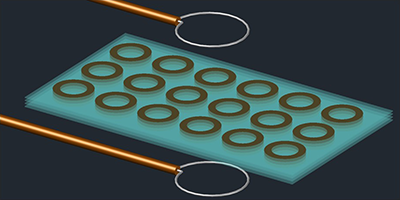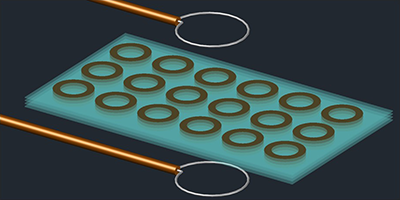Superconducting Antennas Tune In
Metamaterials have been used to build more efficient and directional radio-frequency (rf) antennas for wireless communications. Most schemes, however, work at one fixed frequency and require impractically large components for operation at a few megahertz (MHz)—a frequency range that can be reflected by the Earth’s ionosphere and is thus suitable for long-range communications. Now, a team led by Steven Anlage at the University of Maryland, College Park, has demonstrated a new metamaterial, made with superconducting elements, that could be used to build tunable and efficient rf antennas.
The device consists of two-dimensional arrays of spirals made of niobium, a superconductor with a critical temperature ( ) of . Several arrays are stacked on top of each other to form a three-dimensional structure, which was placed between transmitting and receiving antennas to study its electromagnetic response. Below , each spiral acts like an inductor-capacitor circuit with a sharp resonance. In isolation, each spiral resonates at , but the coupling between multiple spirals shifts the resonance of the entire structure to lower frequencies. The authors demonstrated that this resonance can be tuned over a -MHz range by varying the temperature by a few degrees. The effect occurs because temperature controls the density of superconducting electrons and thus the effective inductance of each resonator. The metamaterial structure could be placed near a radio-frequency source to improve the source’s coupling to free space and boost its efficiency.
This research is published in Physical Review Applied.
–Matteo Rini





